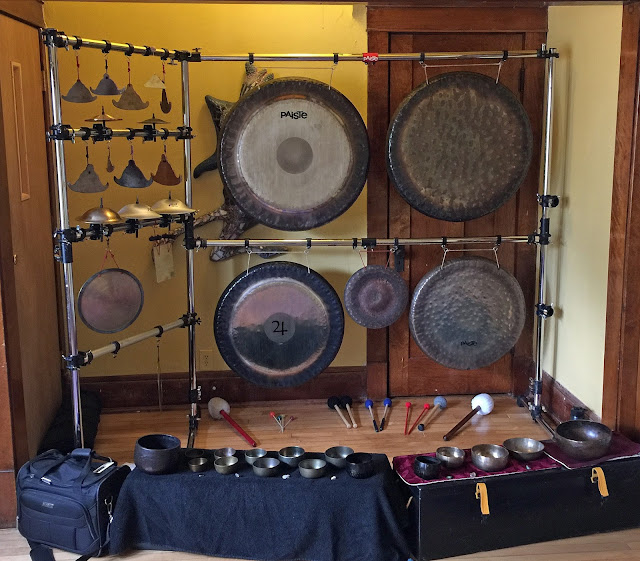Maintaining Your Mallets
Mallets, sticks, wands, strikers—these are your tools. Much like a wrench or hammer, to a plumber or carpenter, these are the tools we use to do our work. We can have all the best instruments, but if our mallets are in bad shape, we won't get the best sound or response. So taking care of them is a must. Besides, they are expensive. and if you are like me, you may have a lot of different mallets that you use, which is a large investment.
I can't believe how many people I see who just throw their mallets in a case or bag with their stand. Of course the stands are hard, and they can easily damage your mallets. Care must especially be taken with Singing Bowl Wands. You want to avoid nicks and dings that will interfere with getting a good, clean sound as you move them around the bowls. Wrapped and covered mallets can become frayed or torn if thrown into a case with hardware/stands. The mallets shafts can become kicked or damaged, which can make them uncomfortable to hold.
If you travel, the most basic thing to do is invest in some sort of bag just for your mallets. There are specific ones designed for mallets (I use the small Mike Balter bags), or you can easily find something else that will work. I often use a small gym bag for my large mallets.
I've traveled all over with my mallets and they are all in great shape.
Good Mallets Gone Bad
Let's face it, as well as you take care of your mallets, they will eventually wear out. Synthetic wool, yarn, cord, rubber, etc. will become worn, frayed, or broken over time. For big, padded Gong mallets, Vic Firth offers 2 different sized synthetic fur recovering kits (GB-1 & GB-2). They are easy to use and will fit other mallets besides the Firth ones. I recently recovered my large Firth GB-1 Gong mallet and it's now as good as new. You can buy these from a music store or on Ebay.
I also use a lot of cord wound vibe and yarn wound marimba mallets on my Gongs/Bowls/Bells. These wear out after much use as the cord/yarn breaks and frays. They need to be replaced! Fortunately, when I was at University, my percussion instructor had studied under Vic Firth and was very into making and repairing mallets. So I learned how to wrap cord/yarn mallets; cut, shape, and sew felt timpani mallets; and fix/make various other mallets and strikers. I've been making and repairing mallets for over 40 years now.
The above photo shows mallets in various stages of use. When mine wear out like this, I often rewrap them, like the one on the right, for practice, or to make something different for a specific sound I'm hearing. This one was my experiment to make a mallet with a larger, yet soft head for some bossed Gongs in a composition I wrote.
If you are interested in rewrapping your own mallets, there are various videos on YouTube, or you can purchase a well made video & pdf instructions from Australian percussionist, Jim McCarthy.
Just remember, your mallets are your tools, so keep them in the best possible condition and they will last longer. They will also help you get the best sounds from your instruments.
~ MB
I can't believe how many people I see who just throw their mallets in a case or bag with their stand. Of course the stands are hard, and they can easily damage your mallets. Care must especially be taken with Singing Bowl Wands. You want to avoid nicks and dings that will interfere with getting a good, clean sound as you move them around the bowls. Wrapped and covered mallets can become frayed or torn if thrown into a case with hardware/stands. The mallets shafts can become kicked or damaged, which can make them uncomfortable to hold.
If you travel, the most basic thing to do is invest in some sort of bag just for your mallets. There are specific ones designed for mallets (I use the small Mike Balter bags), or you can easily find something else that will work. I often use a small gym bag for my large mallets.
Small mallets secure in their bags
I've traveled all over with my mallets and they are all in great shape.
Good Mallets Gone Bad
Let's face it, as well as you take care of your mallets, they will eventually wear out. Synthetic wool, yarn, cord, rubber, etc. will become worn, frayed, or broken over time. For big, padded Gong mallets, Vic Firth offers 2 different sized synthetic fur recovering kits (GB-1 & GB-2). They are easy to use and will fit other mallets besides the Firth ones. I recently recovered my large Firth GB-1 Gong mallet and it's now as good as new. You can buy these from a music store or on Ebay.
Padded mallets, L-R:
1970s Paiste with worn and yellowed fur.
Vic Firth GB-1 with dirty, matted Fur.
Older Mallet with fur in good shape.
Vic Firth GB-1: old fur & new recovering kit.
Hard felt head of Firth GB-1.
GB-1 with new covering.
L-R: frayed cord, frayed yarn, rewrapped yarn.
The above photo shows mallets in various stages of use. When mine wear out like this, I often rewrap them, like the one on the right, for practice, or to make something different for a specific sound I'm hearing. This one was my experiment to make a mallet with a larger, yet soft head for some bossed Gongs in a composition I wrote.
From 1971, the mallet repair bible. Still available.
If you are interested in rewrapping your own mallets, there are various videos on YouTube, or you can purchase a well made video & pdf instructions from Australian percussionist, Jim McCarthy.
Just remember, your mallets are your tools, so keep them in the best possible condition and they will last longer. They will also help you get the best sounds from your instruments.
~ MB
Chop Water / Carry Wood / Play Gongs™










Comments
Post a Comment